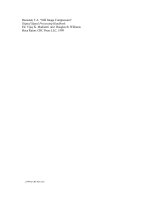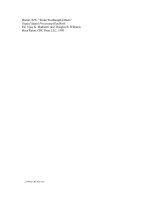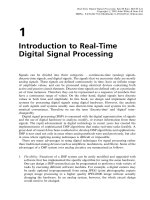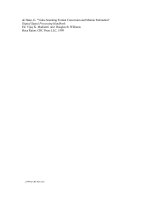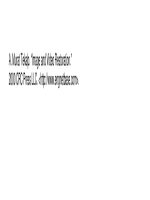Digital Signal Processing P1
Bạn đang xem bản rút gọn của tài liệu. Xem và tải ngay bản đầy đủ của tài liệu tại đây (427.93 KB, 40 trang )
Contents
PART I Signals and Systems
1
Fourier Series, Fourier Transforms, and the DFT W. Kenneth Jenkins
2
Ordinary Linear Differential and Difference Equations B.P. Lathi
3
Finite Wordlength Effects Bruce W. Bomar
PART II Signal Representation and Quantization
4
On Multidimensional Sampling Ton Kalker
5
Analog-to-Digital Conversion Architectures Stephen Kosonocky and Peter Xiao
6
Quantization of Discrete Time Signals Ravi P. Ramachandran
PART III Fast Algorithms and Structures
7
Fast Fourier Transforms: A Tutorial Review and a State of the Art P. Duhamel and M.
Vetterli
8
Fast Convolution and Filtering Ivan W. Selesnick and C. Sidney Burrus
9
Complexity Theory of Transforms in Signal Processing Ephraim Feig
10
Fast Matrix Computations Andrew E. Yagle
11
Digital Filtering Lina J. Karam, James H. McClellan, Ivan W. Selesnick, and C. Sidney
Burrus
PART V Statistical Signal Processing
12
Overview of Statistical Signal Processing Charles W. Therrien
13
Signal Detection and Classification Alfred Hero
14
Spectrum Estimation and Modeling Petar M. Djuri´c and Steven M. Kay
15
Estimation Theory and Algorithms: From Gauss to Wiener to Kalman JerryM.Mendel
16
Validation, Testing, and Noise Modeling Jitendra K. Tugnait
17
Cyclostationary Signal Analysis Georgios B. Giannakis
PART VI Adaptive Filtering
18
Introduction to Adaptive Filters Scott C. Douglas
19
Convergence Issues in the LMS Adaptive Filter Scott C. Douglas and Markus Rupp
20
Robustness Issues in Adaptive Filtering Ali H. Sayed and Markus Rupp
21
Recursive Least-Squares Adaptive Filters Ali H. Sayed and Thomas Kailath
22
Transform Domain Adaptive Filtering W. Kenneth Jenkins and Daniel F. Marshall
23
Adaptive IIR Filters Geoffrey A. Williamson
24
Adaptive Filters for Blind Equalization Zhi Ding
c
1999 by CRC Press LLC
PART VII Inverse Problems and Signal Reconstruction
25
Signal Recovery from Partial Information Christine Podilchuk
26
Algorithms for Computed Tomography Gabor T. Herman
27
Robust Speech Processing as an Inverse Problem Richard J. Mammone and Xiaoyu Zhang
28
Inverse Problems, Statistical Mechanics and Simulated Annealing K. Venkatesh Prasad
29
Image Recovery Using the EM Algorithm Jun Zhang and Aggelos K. Katsaggelos
30
Inverse Problems in Array Processing KevinR.Farrell
31
Channel Equalization as a Regularized Inverse Problem John F. Doherty
32
Inverse Problems in Microphone Arrays A.C. Surendran
33
Synthetic Aperture Radar Algorithms Clay Stewart and Vic Larson
34
Iterative Image Restoration Algorithms Aggelos K. Katsaggelos
PART VIII Time Frequency and Multirate Signal Processing
35
Wavelets and Filter Banks Cormac Herley
36
Filter Bank Design Joseph Arrowood, Tami Randolph, and Mark J.T. Smith
37
Time-Varying Analysis-Synthesis Filter Banks Iraj Sodagar
38
Lapped Transforms Ricardo L. de Queiroz
PART IX Digital Audio Communications
39
Auditory Psychophysics for Coding Applications Joseph L. Hall
40
MPEG Digital Audio Coding Standards Peter Noll
41
Digital Audio Coding: Dolby AC-3 Grant A. Davidson
42
The Perceptual Audio Coder (PAC) Deepen Sinha, James D. Johnston, Sean Dorward, and
Schuyler R. Quackenbush
43
Sony Systems Kenzo Akagiri, M.Katakura, H. Yamauchi, E. Saito, M. Kohut, Masayuki
Nishiguchi, and K. Tsutsui
PART X Speech Processing
44
Speech Production Models and Their Digital Implementations M. Mohan Sondhi and
Juergen Schroeter
45
Speech Coding RichardV.Cox
46
Text-to-Speech Synthesis Richard Sproat and Joseph Olive
47
Speech Recognition by Machine Lawrence R. Rabiner and B. H. Juang
48
Speaker Verification Sadaoki Furui and Aaron E. Rosenberg
49
DSP Implementations of Speech Processing Kurt Baudendistel
50
Software Tools for Speech Research and Development John Shore
PART XI Image and Video Processing
51
Image Processing Fundamentals Ian T. Young, Jan J. Gerbrands, and Lucas J. van Vliet
52
Still Image Compression Tor A. Ramstad
53
Image and Video Restoration A. Murat Tekalp
54
Video Scanning Format Conversion and Motion Estimation Gerard de Haan
c
1999 by CRC Press LLC
55
Video Sequence Compression Osama Al-Shaykh, Ralph Neff, David Taubman, and
Avideh Zakhor
56
Digital Television Kou-Hu Tzou
57
Stereoscopic Image Processing Reginald L. Lagendijk, Ruggero E.H. Franich, and Emile A.
Hendriks
58
A Survey of Image Processing Software and Image Databases Stanley J. Reeves
59
VLSI Architectures for Image Communications P. Pirsch and W. Gehrke
PART XII Sensor Array Processing
60
Complex Random Variables and Stochastic Processes Daniel R. Fuhrmann
61
Beamforming Techniques for Spatial Filtering Barry Van Veen and Kevin M. Buckley
62
Subspace-Based Direction Finding Methods Egemen Gonen and Jerry M. Mendel
63
ESPRIT and Closed-Form 2-D Angle Estimation with Planar Arrays Martin Haardt,
Michael D. Zoltowski, Cherian P. Mathews, and Javier Ramos
64
A Unified Instrumental Variable Approach to Direction Finding in Colored Noise Fields
P. Stoica, M. Viberg, M. Wong, and Q. Wu
65
Electromagnetic Vector-Sensor Array Processing Arye Nehorai and Eytan Paldi
66
Subspace Tracking R.D. DeGroat, E.M. Dowling, and D.A. Linebarger
67
Detection: Determining the Number of Sources Douglas B. Williams
68
Array Processing for Mobile Communications A. Paulraj and C. B. Papadias
69
Beamforming with Correlated Arrivals in Mobile Communications Victor A.N. Barroso
and Jos´e M.F. Moura
70
Space-Time Adaptive Processing for Airborne Surveillance Radar Hong Wang
PART XIII Nonlinear and Fractal Signal Processing
71
Chaotic Signals and Signal Processing Alan V. Oppenheim and Kevin M. Cuomo
72
Nonlinear Maps Steven H. Isabelle and Gregory W. Wornell
73
Fractal Signals Gregory W. Wornell
74
Morphological Signal and Image Processing Petros Maragos
75
Signal Processing and Communication with Solitons Andrew C. Singer
76
Higher-Order Spectral Analysis Athina P. Petropulu
PART XIV DSP Software and Hardware
77
Introduction to the TMS320 Family of Digital Signal Processors Panos Papamichalis
78
Rapid Design and Prototyping of DSP Systems T. Egolf, M. Pettigrew, J. Debardelaben, R.
Hezar, S. Famorzadeh, A. Kavipurapu, M. Khan, Lan-Rong Dung, K. Balemarthy, N. Desai,
Yong-kyu Jung, and V. Madisetti
c
1999 by CRC Press LLC
To our families
c
1999 by CRC Press LLC
Preface
Digital Signal Processing (DSP) is concerned with the theoretical and practical aspects of representing
information bearing signals in digital form and with using computers or special purpose digital
hardware either to extract that information or to transform the signals in useful ways. Areas where
digital signal processing has made a significant impact include telecommunications, man-machine
communications, computer engineering, multimedia applications, medical technology, radar and
sonar, seismic data analysis, and remote sensing, to name just a few.
During thefirstfifteenyearsof itsexistence, the fieldof DSPsawadvancementsinthe basictheory of
discrete-timesignals and processing tools. This work included suchtopics as fast algorithms, A/D and
D/A conversion, and digital filter design. The past fifteen years has seen an ever quickening growth
of DSP in application areas such as speech and acoustics, video, radar, and telecommunications.
Much of this interest in using DSP has been spurred on by developments in computer hardware and
microprocessors. Digital Signal Processing Handbook CRCnetBASE is an attempt to capture the entire
range of DSP: from theory to applications — from algorithms to hardware.
Given the widespread use of DSP, a need developed for an authoritative reference, written by some
ofthe topexperts in the world. This needwas toprovide information onboth theoreticaland practical
issues suitable for a broad audience — ranging from professionals in electrical engineering, computer
science, and relatedengineering fields, to managers involved indesign and marketing, and to graduate
students and scholars in the field. Given the large number of excellent introductory texts in DSP,
it was also important to focus on topics useful to the engineer or scholar without overemphasizing
those aspects that are already widely accessible. In short, we wished to create a resource that was
relevant to the needs of the engineering community and that will keep them up-to-date in the DSP
field.
A task of this magnitude was only possible through the cooperation of many of the foremost DSP
researchers and practitioners. This collaboration, over the past threeyears, has resultedin a CD-ROM
containing a comprehensive range of DSP topics presented with a clarity of vision and a depth of
coverage that is expected to inform, educate, and fascinate the reader. Indeed, many of the articles,
written by leaders in their fields, embody unique visions and perceptions that enable a quick, yet
thorough, exposure to knowledge garnered over years of development.
As with other CRC Press handbooks, we have attempted to provide a balance between essential
information, background material, technical details, and introduction to relevant standards and
software. The Handbook pays equal attention to theory, practice, and application areas. Digital
Signal Processing Handbook CRCnetBASE can be used in a number of ways. Most users will look up
a topic of interest by using the powerful search engine and then viewing the applicable chapters. As
such, each chapter has been written to stand alone and give an overview of its subject matter while
providing key references for those interested in learning more. Digital Signal Processing Handbook
CRCnetBASE can also be used as a reference book for graduate classes, or as supporting material
for continuing education courses in the DSP area. Industrial organizations may wish to provide
the CD-ROM with their products to enhance their value by providing a standard and up-to-date
reference source.
Wehave beenvery impressedwith the quality ofthis work, whichis dueentirelyto thecontributions
of all the authors, and we would like to thank them all. The Advisory Board was instrumental in
helping to choose subjects and leaders for all the sections. Being experts in their fields, the section
leaders provided the vision and fleshed out the contents for their sections.
c
1999 by CRC Press LLC
Finally, the authors produced the necessary content for this work. To them fell the challenging
task of writing for such a broad audience, and they excelled at their jobs.
In addition to these technical contributors, we wish to thank a number of outstanding individuals
whose administrative skills made this project possible. Without the outstanding organizational skills
of Elaine M. Gibson, this handbook may never have been finished. Not only did Elaine manage the
paperwork, but she had the unenviable task of reminding authors about deadlines and pushing them
to finish. We also thank a number of individuals associated with the CRC Press Handbook Series
over a period of time, especially Joel Claypool, Dick Dorf, Kristen Maus, Jerry Papke, Ron Powers,
Suzanne Lassandro, and Carol Whitehead.
We welcome you to this handbook, and hope you find it worth your interest.
Vijay K. Madisetti and Douglas B. Williams
Center for Signal and Image Processing
School of Electrical and Computer Engineering
Georgia Institute of Technology
Atlanta, Georgia
c
1999 by CRC Press LLC
Editors
Vijay K. Madisetti is an Associate Professor in the School of Electrical and Computer Engineering
at Georgia Institute of Technology in Atlanta. He teaches undergraduate and graduate courses in
signal processing and computer engineering, and is affiliated with the Center for Signal and Image
Processing (CSIP) and the Microelectronics Research Center (MiRC) on campus. He received his B.
Tech (honors) from the Indian Institute of Technology (IIT), Kharagpur, in 1984, and his Ph.D. from
the University of California at Berkeley, in 1989, in electrical engineering and computer sciences.
Dr. Madisetti is active professionally in the area of signal processing, having served as an Associate
Editor of the IEEE Transactions on Circuits and Systems II, the International Journal in Computer
Simulation, and the Journal of VLSI Signal Processing. He has authored, co-authored, or edited six
books in the areas of signal processing and computer engineering, including VLSI Digital Signal
Processors (IEEE Press, 1995), Quick-Turnaround ASIC Design in VHDL (Kluwer, 1996), and a CD-
ROM tutorial on VHDL (IEEE Standards Press, 1997). He serves as the IEEE Press Signal Processing
Society liaison, and is counselor to Georgia Tech’s IEEE Student Chapter, which is one of the largest
in the world with over 600 members in 1996. Currently, he is serving as the Technical Director of
DARPA’s RASSP Education and Facilitation program, a multi-university/industry effort to develop
a new digital systems design education curriculum.
Dr. Madisetti is a frequent consultant to industry and the U.S. government, and also serves
as the President and CEO of VP Technologies, Inc., Marietta, GA., a corporation that specializes
in rapid prototyping, virtual prototyping, and design of embedded digital systems. Dr. Madis-
etti’s home page URL is at and he can be reached at
c
1999 by CRC Press LLC
Editors
Douglas B. Williams received the B.S.E.E. degree (summa cum laude), the M.S. degree, and
the Ph.D. degree, in electrical and computer engineering from Rice University, Houston, Texas in
1984, 1987, and 1989, respectively. In 1989, he joined the faculty of the School of Electrical and
Computer Engineering at the Georgia Institute of Technology, Atlanta, Georgia, where he is currently
an Associate Professor. There he is also affiliated with the Center for Signal and Image Processing
(CSIP) and teaches courses in signal processing and telecommunications.
Dr. Williams has served as an Associate Editor of the IEEE Transactions on Signal Processing and
was on the conference committee for the 1996 International Conference on Acoustics, Speech, and
Signal Processing that was held in Atlanta. He is currently the faculty counselor for Georgia Tech’s
student chapter of the IEEE Signal Processing Society. He is a member of the Tau Beta Pi, Eta Kappa
Nu, and Phi Beta Kappa honor societies.
Dr. Williams’s current research interests are in statistical signal processing with emphasis on radar
signal processing, communications systems, and chaotic time-series analysis. More information on
his activities may be found on his home page at He can also
be reached at
c
1999 by CRC Press LLC
I
SignalsandSystems
VijayK.Madisetti
GeorgiaInstituteofTechnology
DouglasB.Williams
GeorgiaInstituteofTechnology
1FourierSeries,FourierTransforms,andtheDFT W.KennethJenkins
Introduction
•
FourierSeriesRepresentationofContinuousTimePeriodicSignals
•
TheClassical
FourierTransformforContinuousTimeSignals
•
TheDiscreteTimeFourierTransform
•
The
DiscreteFourierTransform
•
FamilyTreeofFourierTransforms
•
SelectedApplicationsofFourier
Methods
•
Summary
2OrdinaryLinearDifferentialandDifferenceEquations B.P.Lathi
DifferentialEquations
•
DifferenceEquations
3FiniteWordlengthEffects BruceW.Bomar
Introduction
•
NumberRepresentation
•
Fixed-PointQuantizationErrors
•
Floating-PointQuan-
tizationErrors
•
RoundoffNoise
•
LimitCycles
•
OverflowOscillations
•
CoefficientQuantization
Error
•
RealizationConsiderations
T
HESTUDYOF“SIGNALSANDSYSTEMS”hasformedacornerstoneforthedevelopmentof
digitalsignalprocessingandiscrucialforallofthetopicsdiscussedinthisHandbook.While
thereaderisassumedtobefamiliarwiththebasicsofsignalsandsystems,asmallportionis
reviewedinthischapterwithanemphasisonthetransitionfromcontinuoustimetodiscretetime.
Thereaderwishingmorebackgroundmayfindinitanyofthemanyfinetextbooksinthisarea,for
example[1]-[6].
Inthechapter“FourierSeries,FourierTransforms,andtheDFT”byW.KennethJenkins,many
importantFouriertransformconceptsincontinuousanddiscretetimearepresented.Thediscrete
Fouriertransform(DFT),whichformsthebackboneofmoderndigitalsignalprocessingasitsmost
commonsignalanalysistool,isalsodescribed,togetherwithanintroductiontothefastFourier
transformalgorithms.
In“OrdinaryLinearDifferentialandDifferenceEquations”,theauthor,B.P.Lathi,presentsa
detailedtutorialofdifferentialanddifferenceequationsandtheirsolutions.Becausetheseequations
arethemostcommonstructuresforbothimplementingandmodellingsystems,thisbackgroundis
necessaryfortheunderstandingofmanyofthelatertopicsinthisHandbook.Ofparticularinterest
areanumberofsolvedexamplesthatillustratethesolutionstotheseformulations.
c
1999byCRCPressLLC
While most software based on workstations and PCs is executed in single or double precision
arithmetic, practical realizations for some high throughput DSP applications must be implemented
in fixed point arithmetic. These low cost implementations are still of interest to a wide community
in the consumer electronics arena. The chapter “Finite Wordlength Effects” by Bruce W. Bomar
describes basic number representations, fixed and floating point errors, roundoff noise, and practical
considerations for realizations of digital signal processing applications, with a special emphasis on
filtering.
References
[1] Jackson, L.B.,
Signals, Systems, and Transforms,
Addison-Wesley, Reading, MA, 1991.
[2] Kamen, E.W. and Heck, B.S.,
Fundamentals of Signals and Systems Using MATLAB
, Prentice-Hall,
Upper Saddle River, NJ, 1997.
[3] Oppenheim, A.V. and Willsky, A.S., with Nawab, S.H.,
Signals and Systems
, 2nd Ed., Prentice-Hall,
Upper Saddle River, NJ, 1997.
[4] Strum, R.D.andKirk, D.E.,
ContemporaryLinearSystems UsingMATLAB
,PWSPublishing,Boston,
MA, 1994.
[5] Proakis, J.G. and Manolakis, D.G.,
Introduction to Digital Signal Processing
, Macmillan, New York;
Collier Macmillan, London, 1988.
[6] Oppenheim, A.V. and Schafer, R.W.,
Discrete Time Signal Processing
, Prentice-Hall, Englewood
Cliffs, NJ, 1989.
c
1999 by CRC Press LLC
1
Fourier Series, Fourier Transforms,
and the DFT
W. Kenneth Jenkins
University of Illinois,
Urbana-Champaign
1.1Introduction
1.2FourierSeriesRepresentationofContinuousTime
PeriodicSignals
Exponential Fourier Series
•
The Trigonometric Fourier Series
•
Convergence of the Fourier Series
1.3TheClassicalFourierTransformforContinuousTime
Signals
PropertiesoftheContinuousTimeFourierTransform
•
Fourier Spectrum of the Continuous Time Sampling Model
•
Fourier Transform of Periodic Continuous Time Signals
•
The
Generalized Complex Fourier Transform
1.4TheDiscreteTimeFourierTransform
Properties of the Discrete Time Fourier Transform
•
Relation-
ship between the Continuous and Discrete Time Spectra
1.5TheDiscreteFourierTransform
Properties of the Discrete Fourier Series
•
Fourier Block Pro-
cessing in Real-Time Filtering Applications
•
Fast Fourier
Transform Algorithms
1.6FamilyTreeofFourierTransforms
1.7SelectedApplicationsofFourierMethods
Fast Fourier Transform in Spectral Analysis
•
Finite Impulse
Response Digital Filter Design
•
Fourier Analysis of Ideal and
Practical Digital-to-Analog Conversion
1.8Summary
References
1.1 Introduction
Fourier methods are commonly used for signal analysis and system design in modern telecommu-
nications, radar, and image processing systems. Classical Fourier methods such as the Fourier series
and the Fourier integral are used for continuous time (CT) signals and systems, i.e., systems in which
a characteristic signal, s(t),isdefinedatallvaluesoft on the continuum −∞ <t<∞ .Amore
recentlydeveloped set of Fourier methods, including the discrete time Fourier transform (DTFT) and
the discrete Fourier transform (DFT), are extensions of basic Fourier concepts that apply to discrete
time (DT) signals. A characteristic DT signal, s[n], is defined only for values of n where n is an
integer in the range −∞ <n<∞. The following discussion presents basic concepts and outlines
important properties for both the CT and DT classes of Fourier methods, with a particular emphasis
on the relationships between these two classes. The class of DT Fourier methods is particularly useful
c
1999 by CRC Press LLC
as a basis for digital signal processing (DSP) because it extends the theory of classical Fourier analysis
to DT signals and leads to many effective algorithms that can be directly implemented on general
computers or special purpose DSP devices.
Therelationshipbetweenthe CTandtheDT domainsischaracterizedbythe operationsof sampling
and reconstruction. If s
a
(t) denotes a signal s(t) that has been uniformly sampled every T seconds,
then the mathematical representation of s
a
(t) is given by
s
a
(t) =
∞
n=−∞
s(t)δ(t − nT )
(1.1)
where δ(t) is a CT impulse function defined to be zero for all t = 0, undefined at t = 0, and has
unit area when integrated from t =−∞to t =+∞. Because the only places at which the product
s(t)δ(t −nT ) is not identically equal to zeroare at the sampling instances, s(t)in (1.1) can be replaced
with s(nT ) without changing the overall meaning of the expression. Hence, an alternate expression
for s
a
(t) that is often useful in Fourier analysis is given by
s
a
(t) =
∞
n=−∞
s(nT )δ(t − nT )
(1.2)
The CT sampling model s
a
(t) consists of a sequence of CT impulse functions uniformly spaced at
intervals of T secondsandweighted bythe valuesof thesignal s(t)atthe samplinginstants, as depicted
in Fig. 1.1. Note that s
a
(t) is not defined at the sampling instants because the CT impulse function
itself is not defined at t = 0. However, the values of s(t) at the sampling instants are imbedded as
“area under the curve” of s
a
(t), and as such represent a useful mathematical model of the sampling
process. In the DT domain the sampling model is simply the sequence defined by taking the values
of s(t) at the sampling instants, i.e.,
s[n]=s(t)|
t=nT
(1.3)
In contrast to s
a
(t), which is not defined at the sampling instants, s[n] is well defined at the sampling
instants, as illustrated in Fig. 1.2. Thus, it is now clear that s
a
(t) and s[n] are different but equivalent
models of the sampling process in the CT and DT domains, respectively. They are both useful for
signal analysis in their corresponding domains. Their equivalence is established by the fact that they
have equal spectra in the Fourier domain, and that the underlying CT signal from which s
a
(t) and
s[n] are derived can be recovered from either sampling representation, provided a sufficiently large
sampling rate is used in the sampling operation (see below).
1.2 Fourier Series Representation of Continuous Time Periodic
Signals
It is convenient to begin this discussion with the classical Fourier series representation of a periodic
time domain signal, and then derive the Fourier integral from this representation by finding the limit
of the Fourier coefficient representation as the period goes to infinity. The conditions under which a
periodic signal s(t) can be expanded in a Fourier series are known as the Dirichet conditions. They
require that in each period s(t) has a finite number of discontinuities, a finite number of maxima
and minima, and that s(t) satisfies the following absolute convergence criterion [1]:
T/2
−T/2
|s(t)| dt < ∞
(1.4)
It is assumed in the following discussion that these basic conditions are satisfied by all functions that
will be represented by a Fourier series.
c
1999 by CRC Press LLC
FIGURE1.1:CTmodelofasampledCTsignal.
FIGURE1.2:DTmodelofasampledCTsignal.
1.2.1 ExponentialFourierSeries
IfaCTsignals(t)isperiodicwithaperiodT,thentheclassicalcomplexFourierseriesrepresentation
ofs(t)isgivenby
s(t)=
∞
n=−∞
a
n
e
jnω
0
t
(1.5a)
whereω
0
=2π/T,andwherethea
n
arethecomplexFouriercoefficientsgivenby
a
n
=(1/T)
T/2
−T/2
s(t)e
−jnω
0
t
dt
(1.5b)
Itiswellknownthatforeveryvalueoftwheres(t)iscontinuous,theright-handsideof(1.5a)
convergestos(t).Atvaluesoftwheres(t)hasafinitejumpdiscontinuity,theright-handside
of(1.5a)convergestotheaverageofs(t
−
)ands(t
+
),wheres(t
−
)≡lim
→0
s(t−)ands(t
+
)≡
lim
→0
s(t+).
Forexample,theFourierseriesexpansionofthesawtoothwaveformillustratedinFig.1.3ischar-
acterizedbyT=2π,ω
0
=1,a
0
=0,anda
n
=a
−n
=Acos(nπ)/(jnπ)forn=1,2,...,.The
coefficientsoftheexponentialFourierseriesrepresentedby(1.5b)canbeinterpretedasthespec-
tralrepresentationofs(t),becausethea
n
-thcoefficientrepresentsthecontributionofthe(nω
0
)-th
frequencytothetotalsignals(t).Becausethea
n
arecomplexvalued,theFourierdomainrepresen-
c
1999byCRCPressLLC
tationhasbothamagnitudeandaphasespectrum.Forexample,themagnitudeofthea
n
isplotted
inFig.1.4forthesawtoothwaveformofFig.1.3.Thefactthatthea
n
constituteadiscretesetis
consistentwiththefactthataperiodicsignalhasa“linespectrum,”i.e.,thespectrumcontainsonly
integermultiplesofthefundamentalfrequencyω
0
.Therefore,theequationpairgivenby(1.5a)
and(1.5b)canbeinterpretedasatransformpairthatissimilartotheCTFouriertransformfor
periodicsignals.ThisleadstotheobservationthattheclassicalFourierseriescanbeinterpreted
asaspecialtransformthatprovidesaone-to-oneinvertiblemappingbetweenthediscrete-spectral
domainandtheCTdomain.Thenextsectionshowshowtheperiodicityconstraintcanberemoved
toproducethemoregeneralclassicalCTFouriertransform,whichappliesequallywelltoperiodic
andaperiodictimedomainwaveforms.
FIGURE1.3:PeriodicCTsignalusedinFourierseriesexample.
FIGURE1.4:MagnitudeoftheFouriercoefficientsforexampleofFigure1.3.
1.2.2 TheTrigonometricFourierSeries
AlthoughFourierseriesexpansionsexistforcomplexperiodicsignals,andFouriertheorycanbe
generalizedtothecaseofcomplexsignals,thetheoryandresultsaremoreeasilyexpressedforreal-
valuedsignals.Thefollowingdiscussionassumesthatthesignals(t)isreal-valuedforthesakeof
simplifyingthediscussion.However,allresultsarevalidforcomplexsignals,althoughthedetailsof
thetheorywillbecomesomewhatmorecomplicated.
Forreal-valuedsignalss(t),itispossibletomanipulatethecomplexexponentialformoftheFourier
seriesintoatrigonometricformthatcontainssin(ω
0
t)andcos(ω
0
t)termswithcorrespondingreal-
c
1999byCRCPressLLC
valued coefficients [1]. The trigonometric form of the Fourier series for a real-valued signal s(t) is
given by
s(t) =
∞
n=0
b
n
cos(nω
0
t) +
∞
n=1
c
n
sin(nω
0
t)
(1.6a)
where ω
0
= 2π/T .Theb
n
and c
n
are real-valued Fourier coefficients determined by
FIGURE 1.5: Periodic CT signal used in Fourier series example 2.
FIGURE 1.6: Fourier coefficients for example of Figure 1.5.
b
0
= (1/T )
T/2
−T/2
s(t) dt
b
n
= (2/T )
T/2
−T/2
s(t)cos(nω
0
t)dt, n = 1, 2,...,
(1.6b)
c
n
= (2/T )
T/2
−T/2
s(t)sin(nω
0
t)dt, n = 1, 2,...,
An arbitrary real-valued signal s(t) can be expressed as a sum of even and odd components, s(t) =
s
even
(t) + s
odd
(t),wheres
even
(t) = s
even
(−t) and s
odd
(t) =−s
odd
(−t), and where s
even
(t) =
[s(t) + s(−t)]/2 and s
odd
(t) =[s(t) − s(−t)]/2. For the trigonometric Fourier series, it can be
shownthat s
even
(t)is represented bythe(even)cosineterms intheinfiniteseries, s
odd
(t)is represented
by the (odd) sine terms, and b
0
is the DC level of the signal. Therefore, if it can be determined by
inspection that a signal has DC level, or if it is even or odd, then the correct form of the trigonometric
c
1999 by CRC Press LLC




